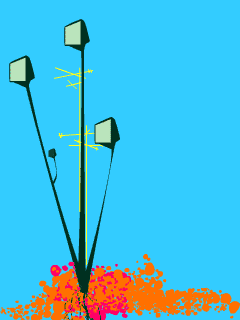Load (and Unload)
Curated by Cristian Silva
Load (and Unload) is a group of audiovisual exercises that explores the Chilean socio-political space from an intimate and allegorical perspective. The poetic response of a generation of Chilean visual artists, suspended historically between a conflicting past and a confusing future, involved in the conjuncture from an affective dimension.
Read the full curatorial essay.
PROGRAM:
The Flintstones by Juan Cespedes
1999, video projection, 1min 30sec
The work of Juan Cespedes is characterized by transgressing and satirizing the characters embedded in contemporary technologies. In this case, Cespedes abstracts images from an episode of The Flinstones to create a subtle and mysterious sequence, when combined with the dialogues and sounds that correspond to the popular cartoon.
View the video
The Delta by Felix Lazo
2002, video, 6min 24 sec
This video in five scenes corresponds to a study of synchronizing the visual and acoustic perception, by means of abstract images and synthetic sounds, that create a particular atmosphere for each scene and generate a reflection regarding our biological make-up. This tape was created in Flash, with images and audio generated with an instrument of modulated frequencies and implemented in Max/Msp by the author himself.
View the video
Dofy and Pililo by Felix Lazo
2000, 4min 55sec loop
View the video
These images were taken in the fall, on the shore of Tongoy, a beach located 400 km north of Santiago. This piece contains several minutes in the lives of a pair of stray dogs that nourish themselves at the edge of the ocean with what the sea brings in and with what is left over by the local fisherman. At the end of the sequence, the scene spins and repeats itself in reverse, in a gesture that accentuates the a-temporality of the situation.
Cigarette by Cristobal Lehyt
2002, DVCam, 59 sec
This video demonstrates how two people can transform a simple exchange in a chance meeting. It is a casual street scene: nowadays, walking through NY is not the same, daily situations have changed and perceived differently, not because of a change of attitude in the population, but rather due to the state of paranoia being fed by the institutional structures.
The new ideal line (meteorito) by Mario Navarro
2001, Video NTSC Color, Stereo, 1min45sec
An enigmatic artificial character waits immobile as time elapses. The passing of time is restless, generating a heavy and dense atmosphere. All of a sudden, a large mass of aluminum paper falls from the sky, and crushes the character. A transformation in the camera’s POV with regards the perception of the objects and their volume occurs; from the simulations of human behavior, to the direct presence of an abstract and informal object.
View the videoThe new ideal line (red-camino) by Mario Navarro
2001-2002, video color NTSC, stereo sound, 6min45sec
The protagonist of this video is a character dressed in a red velvet suit and a very long blonde wig, similar to the character of The New Ideal Line (meteorito). In this case, the character runs untiringly through a somewhat dense and humid forest. Different takes show a relentless velocity and the impossibility of finding a "path", a case almost illustrative of the philosophy that articulates the series of The new ideal line.
View the video
The Falls of the Artist by Macarena Rivas
1995, Video VHS-NTSC-Color, 1min 18sec
Rivas registers the collapse a man in different areas of the labor center of Santiago, representing a situation of defeat and public degradation, reminding us of the comedy routines of silent films. A curious sequence which records a character and his briefcase facing the corporate world.
View the video
Without Title by Francisco Valdes
2002, video projection loop 14min
Reproduction, transformation and obsolescence constitute the central theme of the work by F.J. Valdes, particularly in relation to contemporary media. This piece takes as a principal element the recovery of a black and white 8mm film that describes the industrial process of a sawmill in Oslo, Norway in the 1940’s. Although the footage comes from a very distant source, it suggests the reconfigurations that culture experiments because of technological advances.
Broken Cup by Joe Villablanca
2002, Video clip musical, 3min 30sec
This clip was produced to create a dialogue with the song Taza Rota (Broken Cup), composed and interpreted by the author. In his own words, the descriptions of the actions are as follows: 1. The camera flies through the flowers like a bee. 2. I spit on the camera lens. 3. The camera shows that we are at the National Museum of Arts in Santiago. 4. The camera stays still and I jump into the garden and perform a brief choreography. 5. The choreography ends when I take a drink of milk and spit it out like a fountain. 6. I return to the camera and I draw a diagram of the museum in the sand. 7. The camera tours like a U2 video. 8. I take the carton of milk and water the plants with it. 9. I see one of the flowers through a bottle of coca-cola. 10. A take of the sculpture of Frontis, simulating the sexual relation between Dedalus and Icarus. 11. At the end, the credits, which are stolen from another film.
@ MOCA at California Plaza
Nov. 10, 11am -5pm,
|


